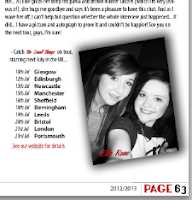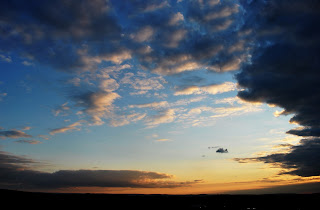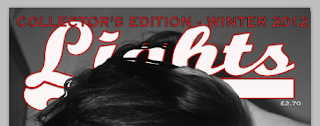Looking back at your preliminary task, what do you feel you have learnt in the progression from that to your full product?
Looking back at my preliminary task, I realise that the difference in skill level is vast. I have learnt a lot about how magazines are produced and especially in what features I need in order to make them look professional. I changed the outlook from my preliminary task to my final product loads; especially with the theme of my retro originality, and use of colour palette and fonts.
When analysing different types of magazines, I realised that probably one of the most important elements was the cover model. Looking back at the front cover of my preliminary task, I realise that the cover model didn't display much emotion or convey anything in particular that was relevant to the magazine I was selling for the college. After researching many different genres of magazines, I have come to realise that differing emotion, such as the hint of sexuality or a mysterious persona, that is portrayed through the cover model can have a major impact on how your magazine is viewed by its consumers.
I know that they were both of myself, but my preliminary task image gave off a very plain student vibe (and I didn't even link it in to a headline on the cover). Whereas on my final product, I hoped to give off the potential vibes of a carefree attitude, with edge appealing to both genders. Also, through changing the colour scheme to black and white thanks to the editing tools in Adobe Photoshop, with my main popping colour of red, I was able to create a look of individualism, with a hint of sophistication, but which obviously wasn't too feminine. I changed the costumes too; my green jumper gave off a calm and collected persona in my preliminary task, but the denim jacket in my final product gave off a edgy rock-chic vibe.
Plus, with the ability to change the effects and colour of the image, it can further represent what type of genre and style your magazine is centered towards. For my preliminary task, my ability to edit and change the look of my images was very limited, because I was using the software, Microsoft Publisher. This was very basic; I could barely cut out the background of my image for the front cover, leaving an awfully non-relevant colour behind. At this point, I used this software because I had no idea on how to use Photoshop, which I now know has a far better range of editing equipment for its consumers to interact with.
The development of my technological use has become a lot more advanced and definitely changed throughout my course. I now know how to grasp a lot of the elements of Photoshop, as well as editing images and texts so that they are relevant to what is being advertised in the task set.
For example, in my preliminary task, I used the most basic of fonts for even my masthead and main sell lines on my front cover; which I now know wouldn't have appealed to a larger audience around the college. It was far too simple, and even the colour scheme at times was too harsh on the eye which I realised wouldn't attract many people because it seemed too tacky. When comparing it to my music magazine's front cover, I can tell the difference straight away. The mastheads are immensely different; my music magazine one is bold and in the middle of the page, with a red outline, accentuating the style I was aiming to give off. I was only able to obtain this text through realising that this software allowed its consumers to download their own fonts so that they could be used in their product. This really helped me along with the process of making my magazine look as professional as it could be with my recent skills acquired of Photoshop.
When I compare both my contents pages from both tasks, I can tell that my skill level has improved a lot, partly due to analysis from realistic magazines, and realising which features are important within them; these elements can range from the all-important feature of your cover model's story, to adding perhaps an editor's note at the top of the page.
First of all, the layout and composition of my final product is a whole lot more professional than that of my preliminary task. In the latter, my choice of colours was minimal, but at the same time, they were really basic and unprofessional because of their boldness, contrasting with the basic fonts. Plus, the preliminary task was pretty much 'cut' into four parts; contents, image, text and a small review. After researching real contents pages, I realise that the quality of mine, plus the relevance and layout was very poor. I didn't know how to construct a contents page properly because of my limited knowledge anyway, plus that current software was far too basic.
So, looking at my music magazine's contents page, I know that I have added pretty much all of the needed aspects of a real one into it; and the outcome is professional, especially the layout. This is due to the fact that everything is spaced out equally, and I knew where to place certain elements of the magazine depending on its importance.
I have realised that through Photoshop, I can create a realistic magazine because of the countless editing tools which are available, unlike on Microsoft Publisher, where I could only really rotate images and maybe take the background out of them.
I've also changed the general contents feature, into something far more exciting to read with the colour palettes and the different tones due to the editing effects. It stands out a lot more than my preliminary contents feature because of this, and especially through adding in quirky fonts like Lemondrop.
On a whole, I feel like I have improved dramatically. Through using relevant sources, like real magazines, peer feedback, Photoshop and coming to terms with how a magazine is put together, I feel as though my final product reflects my step up from my preliminary task loads.












































